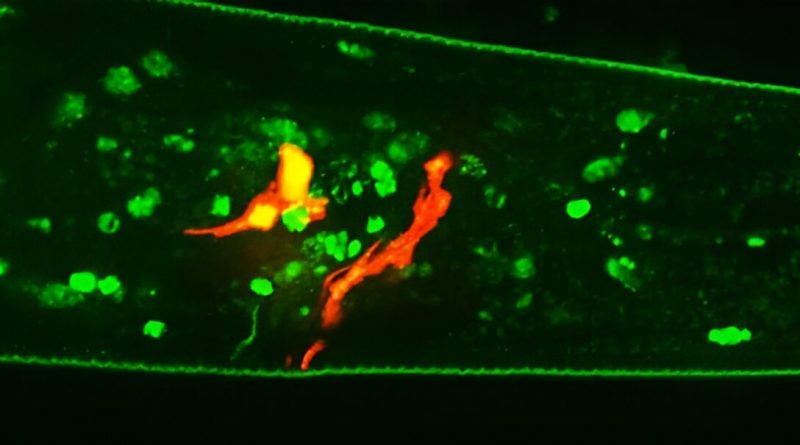Longevity may be associated with olfactory perception of harmful substances

Aversion to an offending smell can be an indicator of the organism’s capacity to protect itself from harmful substances and live longer. This at least is what happens in the case of nematodes of the species Caenorhabditis elegans.
Although nematodes (roundworms or threadworms) do not look remotely like humans, for about 50 years they have been used as a model for biological studies. The advantages include a simple nervous system, few cells and genes, many of which have the same functions as our own, and a short lifespan averaging 17 days, which is ideal for research on aging.
An article published in the journal Nature Aging reports the findings of a study showing that odorant molecules secreted by pathogenic bacteria not only produced an aversive response in C. elegans, which retreated to avoid the threat but also triggered a neural circuit that induced a response in other tissues of the nematode.
This response includes more efficient processing of toxic proteins, and control of the aggregation of these and other proteins produced by the worms. The relevance of this is that in humans a buildup of these proteins is one of the factors associated with neurodegenerative diseases such as Alzheimer’s and Parkinson’s.
“They can sense danger in the environment by smell, heightening their stress responses even before they locate any pathogenic bacteria. Smell also prevents aggregation of proteins involved in disease, potentially extending their lifespan,” said Evandro Araújo de Souza, first author of the article. The study was part of his postdoctoral research at the Neurobiology Division of the Medical Research Council Laboratory of Molecular Biology (MRC-LMB) in Cambridge in the United Kingdom.
Scenting danger
In the study, nematodes exposed to 1-undecene, an odorant molecule, lived longer than those that had no contact with the odor secreted by bacteria. Responses to the stimulus could be seen in the intestine, evidencing the existence of a circuit connecting olfactory perception to the rest of the body.
“These findings suggest that manipulating perceptions of chemical substances could one day be a route to intervention in neurodegenerative and age-related diseases. However, more research is needed to establish whether similar cell signaling pathways and mechanisms also operate in humans,” said Rebecca Taylor, a researcher at MRC-LMB and last author of the article.
According to the researchers, other studies had already shown that mice have a neural circuit linking brain to liver when these animals smell certain kinds of food, and it makes sense to hypothesize that the mammalian nervous system could trigger a response by other organs when stimulated, as is the case in nematodes. “If we find a molecule that can mediate this circuit connecting the perception of odor to the organism’s response, we could have a promising route to develop novel treatments,” Souza said.
Partially revealed circuit
In the study, the nematodes were placed on different plates from those containing the odorants to demonstrate that it was not direct contact between the worms and the substances that caused aversion but only their smell.
The odorants used were those secreted by pathogenic bacteria such as Pseudomonas aeruginosa and Staphylococcus aureus, which are harmful to nematodes. Three of these compounds including 1-undecene were associated with aversive responses in C. elegans. The researchers decided to focus on 1-undecene in subsequent experiments as it induced aversion without being toxic.
When they analyzed the worms exposed to the substance, they observed activation of the endoplasmic reticulum unfolded protein response (UPRER) in the intestine. This is a defense the organism uses to trigger repair mechanisms or eliminate defective proteins.
In worms with mutations in two genes that regulate the UPRER (ire-1 and xbp-1), the response was not activated by 1-undecene, showing that this cellular signaling pathway was essential to activation of UPRER by the substance. Other experiments confirmed this result.
Another group of mutant nematodes exposed to 1-undecene failed to produce neurotransmitters such as serotonin, dopamine and glutamate, among others, but the researchers were unable to identify a role for any of these molecules.
Next, they focused on DAF-7, a protein and gene equivalent to transforming growth factor-beta (TGF-β) in mammals, where it plays an important role in the neural circuits that govern behavior such as aversion to pathogens.
When production of DAF-7 was inhibited, odorant-induced UPRER was not activated, evidencing its role in this response. “We now know the route we need to follow, especially because the protein has an equivalent in humans,” Souza said.
More information:
Evandro A. De-Souza et al, Olfactory chemosensation extends lifespan through TGF-β signaling and UPR activation, Nature Aging (2023). DOI: 10.1038/s43587-023-00467-1
Journal information:
Nature Aging
Source: Read Full Article
